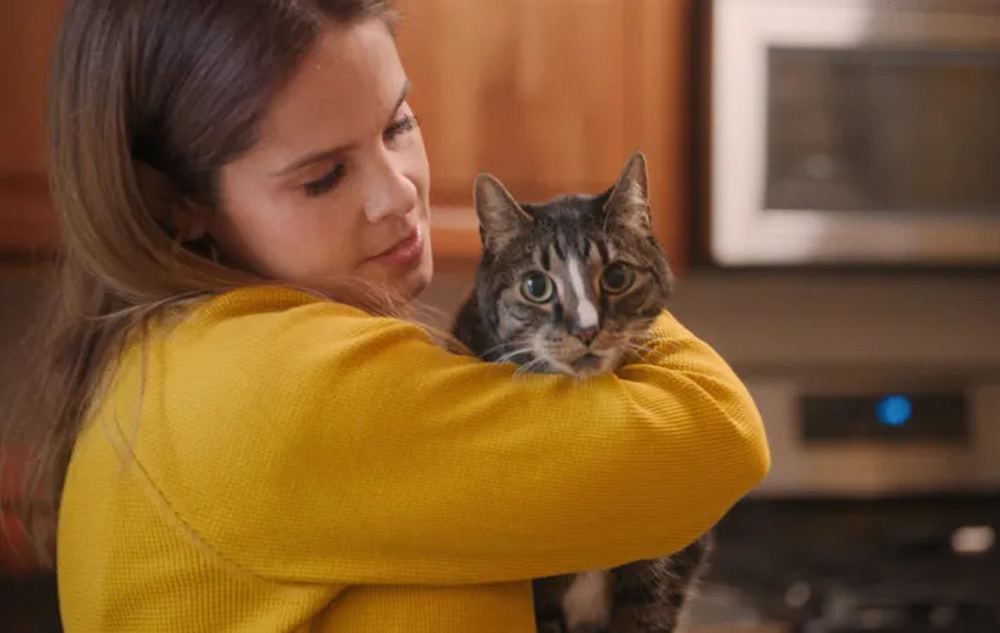Todd Bieber and crew probably didn’t think they’d be putting in a call to the U.S. Naval Institute when they set out to make “American Cats: The Good, the Bad and the Cuddly,” yet they’d end up in plenty of places they couldn’t expect as they charted the nation’s history with felines. It’s how Amy Hoggart, the former “Full Frontal with Samantha Bee” correspondent, would end up sitting across from Scot Christenson, the Naval Institute’s director of communications, discussing how cats made their way to America in part via naval ships as a form of pest control before being embraced as pets, with Hoggart demonstrating just how far they’d come while running her hand across the back of one sitting in her lap. However, Bieber did know in advance of what will likely be the film’s most surprising aspect for audiences when for all its silliness, it reveals itself to be a pretty serious investigation into the practice of declawing, which is shown to be relatively unique to America when pet owners are persuaded to cut their cat’s nails down to the bone to spare their sofas from scratches.
“American Cats” makes no bones itself about where it stands as it ends up focusing on the financial incentive of declawing that has made it a standard operating procedure for many veterinarians despite evidence that the damage that it does goes beyond the physical for the cats that can contract various maladies from the unnecessary surgery or suffer psychological issues in its wake. The film comes to center on veterinarian Dr. Jennifer Conrad, who has spoken up at city council meetings across the country to attempt to place local bans against declawing, finding a constant source of opposition in the American Veterinarian Medical Association, the trade group that aims to protect their members’ business interests and moments after taking the podium herself, Dr. Conrad would often find herself followed by one of their representatives Peter Weinstein, arguing that such regulation is unnecessary.
Weinstein becomes one of many that Hoggart and Bieber get to sit down to talk about declawing, a cross-country trek that takes them into anarchist bookstores, pinball halls and perhaps least expected of all, the apartment of beret-wearing New York iconoclast Curtis Sliwa, fresh off a failed run for New York mayor, where his cats could give him plenty of comfort. Despite the variety of opinions on most other aspects of American life, the filmmakers find consensus around how cats should be treated, expecting them to receive the same level of compassion as their owners get from them. After making its premiere earlier this year just over the border at Hot Docs in Toronto, “American Cats” has been criss-crossing the U.S. in recent weeks and before arriving for a full-fledged theatrical run in Los Angeles, Bieber and Dr. Conrad spoke about how they came to collaborate on the film, finding the humor to make a difficult subject more palatable and cleverly putting cats in charge of the production.
How’d this all start out?
Todd Bieber: I worked on “Full Frontal with Samantha Bee” and with Jordan Klepper. so a mutual person that Jenny and I know [said to me], “You’ve got to hear this story.” And I grew up on a sixth-generation family farm and by the time I was born, it was just cats, so I love cats, so when I heard Jenny’s story, I [thought], “This is absurd. This is crazy that these animals that we love that were supposed to be taken care of, so many people [thought] I’ll take it to my vet and they’re going to make my cat companion better and are actually making them worse. When I heard the way that Jenny struggled through that, I thought, “This is a great documentary.”
Dr. Jennifer Conrad: We collaborated from the beginning after that. He likes to work on things that are absurd but also very important. I think declawing is absurd and and unfortunately is so common. A paw is so integral to a cat, and I think because they suffer in silence, people think that declawing isn’t an issue, but it’s because of the nature of a cat. We’re amputating all of their toe bones, and we think that that’s a painless surgery? I don’t think so.
How did Amy Hoggart come into the mix as a guide?
Todd Bieber: Amy and I both worked at “Full Frontal with Samantha Bee,” and we worked on a ton of field projects where we would go out to NRA conventions and Trump rallies and she and I just got along great. Amy and I are just so aligned and I love working with a host who can be a journey and a guide, and when I knew that Amy loved cats, but was also an outsider to America and this is such a specific American story, [I thought] she can kind of explore it with [this quality that] she doesn’t know everything. I was able to do the research and then guide her through the process of learning everything, which I thought would be a fun way to have Amy be a surrogate for our audience [because] many people don’t know and can approach it with humor. Something that’s important to me is to talk about these topics that people typically don’t want to necessarily dive into [where] having it be funny and filled with cuddly animals is a way that this message is going to get out there, so Amy came on board and was excited to be part of it.
Dr. Jennifer Conrad: And the reason that Todd was such a good director is because he recognized that this is a hard subject to swallow. Many people have declawed cats. They didn’t realize they were denuckling their cats when they did it because their trusted veterinarian said it was okay to do, so when Todd decided that, “Hey, we can make this infinitely watchable because there’s laughs and it’s fun and there’s cute kittens,” but at the same time sending this message that there are these veterinary medical associations that are only interested in money, and they’re the ones who are promoting that you declaw your cat, that was something that had to get through to people, but it’s a big pill to swallow. Todd made it so that they’ll get the message, but they won’t feel devastated. A lot of documentaries, you walk out of them and you feel like, “Oh my goodness, what can I do? I feel so helpless.” But this leaves you feeling empowered and wanting to participate in making change.
It’s incredible for a lot of reasons that you are able to talk to Peter Weinstein, who was essentially a lobbyist for these veterinary medical associations. Narratively alone, he becomes a great foil for Jennifer as an on-screen presence. Did you know early on he was something you could build a story around?
Todd Bieber: It was very difficult to get ahold of the AVMA, but it’s an organization that is made up of individuals and when you have an outspoken person who’s willing to talk to you and to double down on their opinions, but also see their growth, that’s everything you want. Jennifer and I talked about who were adversaries to her throughout her career, and Peter kept coming up. Also Jenny has been documenting her struggle with declawing since the beginning, so at some point, she gave me a hard drive of those 20 years of her documenting this. It was everything from articles to stills to home videos of her working with big cats and saved within that were some of those articles from Peter. When I started reading those, I was like, “This is the guy that I want to talk to about this.” He was going to be at that convention [we were going to cover], so we reached out to him and he was willing to talk to us, so it was serendipitous.
Jennifer, did you actually know your archive could be the foundation for a documentary like this?
Dr. Jennifer Conrad: It started out that we were documenting the surgery when we were revising the paws on the big cats, so that we could see the change [in the cats]. Then we started wanting to film the city council meetings, because with a camera, it makes you realize what the absurdity is, and I was filming it because I wanted to hear the arguments [from the declaring advocates] over and over again so that I could hone my arguments to preempt them. Then it did become obvious that it should be a documentary and we did “The Paw Project,” the first documentary and we got used to filming and we kept filming.
Then when it became time to do a second documentary, I was prepared and I’m glad because when Todd asked for it, I [told him] “I have all this. I don’t know really why I have it, but it was to keep my sanity in the sense that this is really what their arguments are.” For instance, this argument that it’s better to declaw a cat than to have it lose its home, that would be reasonable if declawed cats weren’t so much more likely to lose their homes because they stopped using the [litter] box because it hurts to dig in the sand and they start biting because they have no other way to protect themselves. So that argument was easily refuted. The fact is that declawed cats are very often in the shelters. And then the other argument was that you had to declaw a cat if someone in the house was a baby or an old person because of [something called] Cat Scratch fever and that was not substantiated by the Centers for Disease Control or the Hemophiliac Society, [and the disease] is actually from flea feces getting into any wound, so it could be a paper cut and it was poorly named because it’s not about cat scratches. So this documentary to me is really important in getting that information out there that there is no good reason to declaw a cat.
Todd, was there anything that happened that took this in a direction you didn’t expect?
Todd Bieber: Part of the fun of working with Amy is that her curiosity takes her into funny places, so we ended up in that pinball museum, which was mostly because we knew that there were cats there and we thought it was a visually cool place to talk about cats. But the weirdest place that I ended up was Curtis Sliwa’s 300-square-foot apartment with 18 street cats. He’s a legend here in New York City and he ran for mayor, and he’s a bit of a kook, but he also loves cats. The amazing thing about that space was it didn’t smell at all and he really did take care of those cats, and though I politically don’t agree with him, we do agree with our love of cats, and to go into his apartment, I’m trying to think of another New York legend, but he’s just such a strange institution here in New York, so that was a wild spot for me.
What’s it been like getting the film out into the world?
Todd Bieber: It’s been awesome. You work on a project for long enough, you forget where the funny parts or tender parts are, and then to finally sit down at Hot Docs and at these different festivals and see it with the 300 people and hear them laugh or hear them gasp or hear little sniffles of people crying, you’re like, “Oh yeah, this is why we do it.” Movies are meant to be shared with people, and we set out with a real purpose here to get people to watch it and to care about cats, so to actually get to see people do that has been fun.
Dr. Jennifer Conrad: It’s so fun too because the opening credits are all cats. And the reason we did that [first was] to crowdsource some funding, but also because we can say this is a movie made by cats for cats, but the last reason, which I think is the funniest, is if the AVMA or one of these AVMA sues us, they’re going to be suing a bunch of cats over the right to declaw them, [which] I think is going to be a PR nightmare. But when audiences see it’s a Clawson and Clawson Cinematics Production, and they’re all cats as producers and cinematographers, I think that that sets the tone that it’s okay to laugh in this documentary. It’s okay to feel the joy of cats and just to remember that you feel that joy and you’ve got to protect them and the best way to protect them is to go to a veterinarian who refuses to declaw. If you have to change veterinarians, then let that declawing veterinarian know why you can’t go there anymore because any vet who can declaw is clearly not putting your cat’s best interest forward and veterinarians need to feel that pressure.
“American Cats: The Good, the Bad and the Cuddly” opens in Los Angeles on October 25th at the Laemmle Royal.




